Dying Light 2: Stay Human review

What is it? A first-person open world parkour action game set in the zombie apocalypse.
Expect to pay: $60/£54.99
Developer: Techland
Publisher: Techland
Reviewed on: RTX 2080, Intel i7-9700K , 16GB RAM
Multiplayer: Co-op
I land a flying two-footed kick into a bandit and send him screaming off the edge of a roof and onto the zombie-filled streets below. Over the past 50 hours of Dying Light 2, this has become my singular goal: kick dudes off roofs. The city is in peril from far more than just zombies, I have a half-dozen unfinished side-quests in my journal, and my map is littered with icons imploring me to scavenge resources, discover new locations, and undertake parkour challenges.
Sorry. Can’t do any of that right now. Somewhere in the city another bandit is standing too close to the edge of another rooftop.
And reaching that rooftop is just as much fun as kicking someone off it. To get there I slide down ziplines and bounce off jump-pads, swing like Spider-Man from the rope of my grappling hook, sail through the air with my fold-up paraglider—or I just climb, clamber, wall-run, and ledge-grab my way there. Dying Light 2 is a huge and exhilarating playground for crunchy, kinetic, two-footed combat and satisfying first-person parkour. It doesn’t start out like that—there’s a few long hours before the game really opens up and gets fun, and there’s a lot of not-so-great storytelling along the way. But it’s worth it.
Pilgrimage
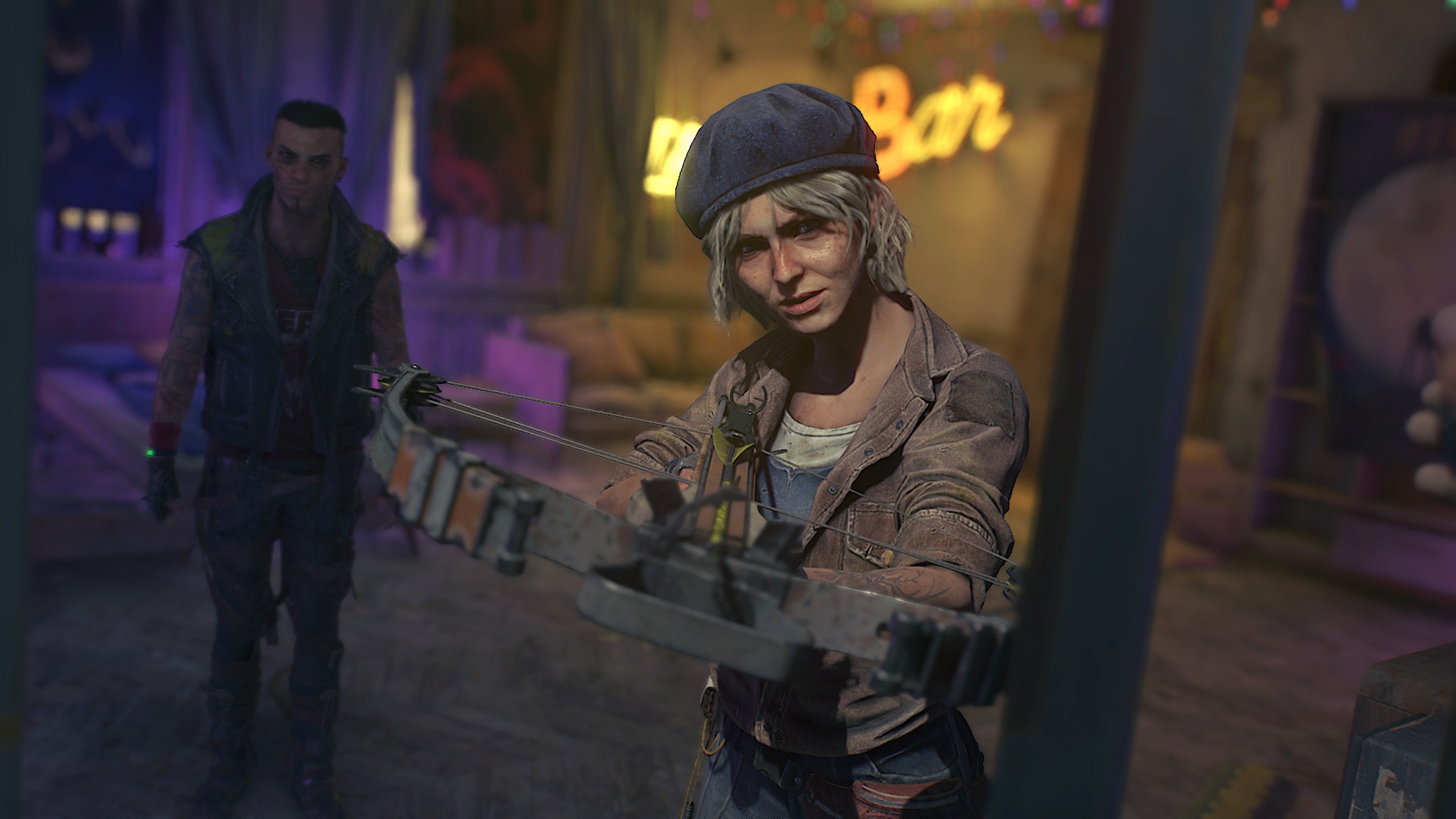
(Image credit: Techland)
Welcome to the European city of Villedor, a sprawling mess of decaying and crumbling buildings with scores of zombies shambling through the streets and pockets of survivors camped out in barricaded safe zones. As Aiden, a travelling do-gooder (called a pilgrim), I’ve arrived in search of my long-lost sister, Mia, following several convenient flashbacks that show we were the victims of medical experiments as children before being separated. After discovering a vaccine for the original zombie virus, scientists continued messing around until they goofed big-time and unleashed an even deadlier version of the disease upon the world. One particularly evil scientist, a man named Waltz, may hold the key to finding my long-lost sister and my long-delayed revenge.
To find Waltz, I need to ingratiate myself with the locals, who are distrustful of outsiders and only give out information in exchange for favors, though thankfully those favors often involve kicking jerks off rooftops. There are two main factions in Villedor—the Survivors, a grubby yet hearty clan who build little farms and safe zones on the rooftops, and the Peacekeepers, who dress in blue combat gear and act like the cops of the apocalypse. When Aiden arrives the two groups are at odds owing to the recent unsolved murder of a Peacekeeper commander, and it’s not long before Aiden’s eager-to-help attitude gets him wrapped up in the drama between the factions.
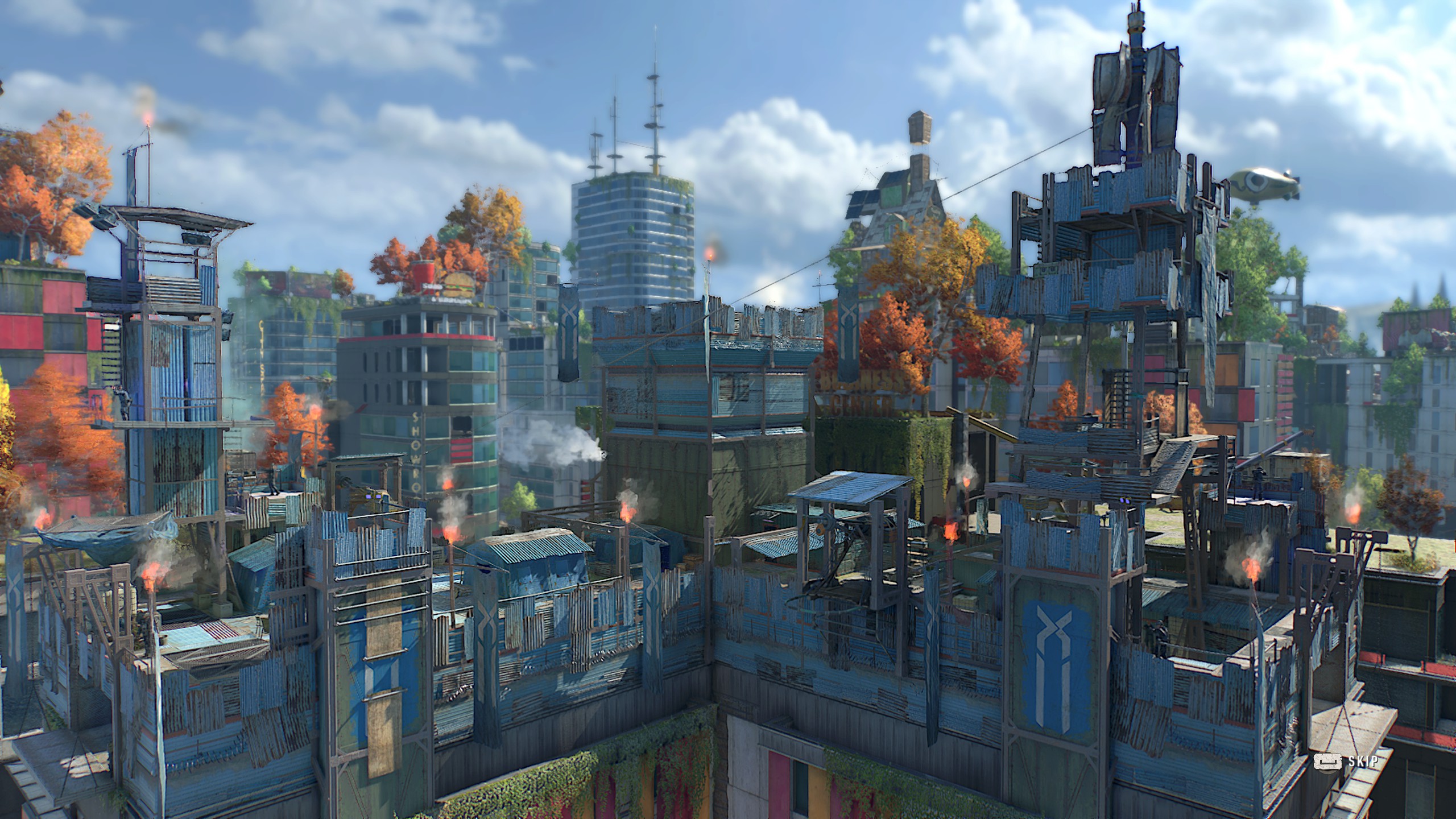
(Image credit: Techland)
I’m not yet a dynamo of flying kicks and fluid parkour when I arrive in Villedor. I’m a complete klutz, a disgrace to the art of climbing walls and running on rooftops. The first few hours of Dying Light 2’s feel shaky, slow, and clumsy—I miss my jumps frequently, hesitate at the ledge of every building before leaping, frequently run out of stamina while climbing, and hammer away at zombies with ineffectual weapons like table legs and baseball bats. Progression is slow: every enemy I kill and wall I climb sends a trickle of combat and parkour XP into my bank, and only once I’ve leveled up those talents am I given a single point to unlock a new move from the two skill trees.
Whereas a game like Far Cry 6 would have thrown loads of exciting weapons and skills at me immediately, in my first 10 hours of Dying Light 2 I’d only added a couple of extra moves to my arsenal. But I’m kind of into that. It makes progress feel earned, something I really have to struggle to accomplish, and it makes deliberating over which skill to pick feel important. Each time I had a point to spend, I really had to consider what would have helped the most while I was getting my ass kicked for the past few hours. And most skills are distinct and useful enough to change the way I approach both fights and parkour.
Feet first
Along with my beloved flying two-footed kick, there’s more fun foot-related skills: a vault kick, which lets me use a stunned foe as a springboard to launch myself, boots-first, into his comrade (and if my kick stuns him I can simply turn around and springboard back to deliver another kick to the first guy). An air kick lets me target a foe from above, leap down, and drive my foot into his face in glorious slow motion. There’s a satisfying headstomp for mashing a fallen enemy’s brains into goo, and even a move that lets me run right into a dude, knock him off a roof, and ride his body all the way to the ground, smashing his skull into the pavement. I know, it’s not a kick, but it’s still an awesome (and hilarious) finisher and a stylish way to get down to street level.
You don’t have to kick everyone to death: there’s a steady supply of sharp, rusty, and spiky melee weapons to collect along with bows and throwing knives for ranged attacks, and explosives like mines and grenades. I grew pretty attached to my gleaming two-handed axe called the Heavy Duty, not just because it could hew off arms, legs, and heads while providing me with a stamina regeneration bonus and a damage bonus when I was at low health, but because it had three sockets I filled with craftable weapon mods that did electrical and toxic damage, turning critical hits into gloriously gory and effective strikes. I liked it so much I installed a third mod that increased its durability.
You can’t repair weapons in Dying Light 2, but I never had one break—by the time my favorite weapons were degrading from use there were newer, deadlier ones to buy or find. I replaced the Heavy Duty in favor of the Bad Gal, a katana that did bonus damage at night and even more bonus damage during the day. I crafted another mod that meant crits would set an enemy on fire, which could spread to an entire mob. Kicking bandits off a roof is even more fun when they’re bleeding and on fire.
There are also great single-use “opportunity weapons” scattered around enemy encounters, like spears that can be snatched from corpses and quickly flung into an enemy for a one-hit kill, or bottles and bricks that can be grabbed and thrown to stun or stagger someone, giving big brawls a fun, improvised feel. And weirdly, my favorite weapon turned out to be the only gun in the game, called the Boomstick. It’s only useful for a single shot and costs so much scrap metal to craft that I didn’t fire it for hours—until a ridiculous bandit boss wearing a bird costume sucker punched me. It barely hurt him, but after hours spent hitting people with clubs and hatchets it felt great to blast him right in the beak.
A slick, unbroken run across a district’s rooftops makes me feel almost superhuman.
Parkour progression doesn’t feel quite as great as adding new combat skills or weapons—at first. It focuses on more practical needs like being able to roll after hitting the ground, or popping back up immediately after landing, or skills that let you leap a bit further or climb a bit quicker. But those skills add up and eventually make movement much more fluid, which gives me plenty of confidence. Being able to slide through a low gap instead of ducking and walking under it never saved my life, but it sure as hell feels good. The city eventually begins to feel less like a bunch of obstacles and more like a jungle gym, and a slick, unbroken run across a district’s rooftops makes me feel almost superhuman.
There are more tools to navigate the city that only arrive about halfway through the main story quests, like the paraglider I can use to sail over rooftops, steering into updrafts from air vents to extend my flight and open up an exciting new avenue of travel. It’s also the perfect way to escape clawing zombie mobs. Eventually I get a grappling hook, too, not a Just Cause-type for yanking myself through the air but one I can sink into an object above me and swing across gaps with like Indiana Jones. With all of these tools in play Villedor becomes a brilliant playground, a massive, zombie-filled puzzle I can solve by climbing, leaping, gliding, and swinging, whether I’m on a quest or just exploring.
Club zed
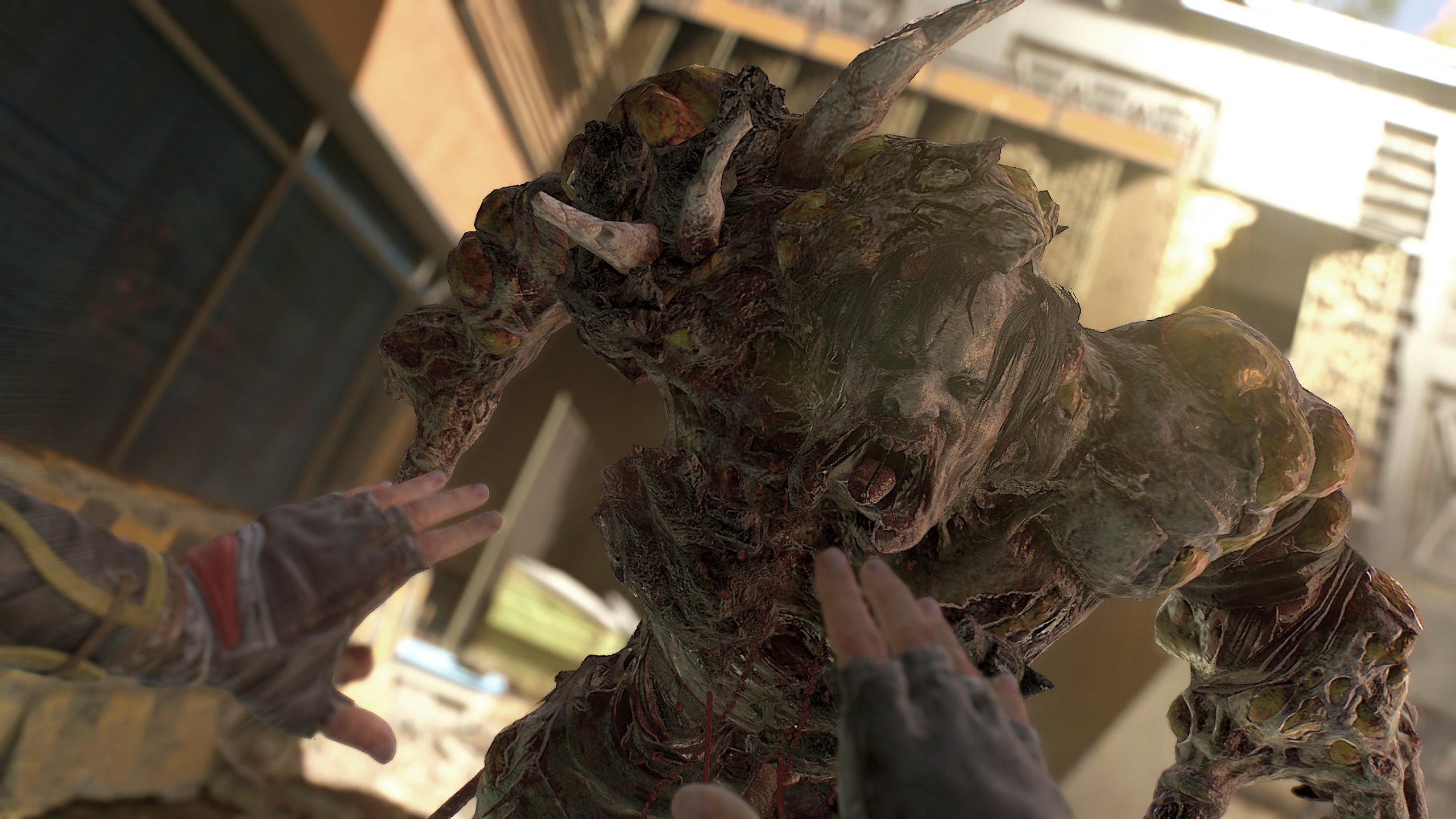
(Image credit: Techland)
I haven’t really mentioned the zombies much because, well, they’re a bit boring and fighting them isn’t nearly as much fun as mixing it up with living humans. Some zombies shamble slowly, some swarm quickly, and there are zombie specials, like howlers who attract mobs, spitters who pelt with ranged attacks, lurching blobby ones who explode, and enormous, slow-moving tanks that ground-pound and windmill with giant fists. In the daytime they rarely feel like much of a threat once I’ve gotten good at parkour, but as in the original Dying Light, nighttime changes everything.
When night falls traversing the city becomes incredibly dangerous as all the zombies who avoid daylight head out onto the streets, much meaner and faster than their daytime counterparts. But night also means the interiors of buildings are easier to navigate since most of the hordes are outside. Nighttime activities reward you with more loot and increased XP, so it’s a real risk-vs-reward prospect. It’s also a fantastic way to add tension. Creeping past slumbering zombies who might wake up at any moment or scuttling across rooftops hoping I don’t do anything to make noise and alert the mob always has me holding my breath. And finishing up a long mission and realizing night has nearly fallen is a real oh-shit moment, followed by a mad dash to a safe zone as warning bells sound across the city and the howls of the undead begin rising in my ears. Parkour while panicking is the true test of your skills.
Control Points
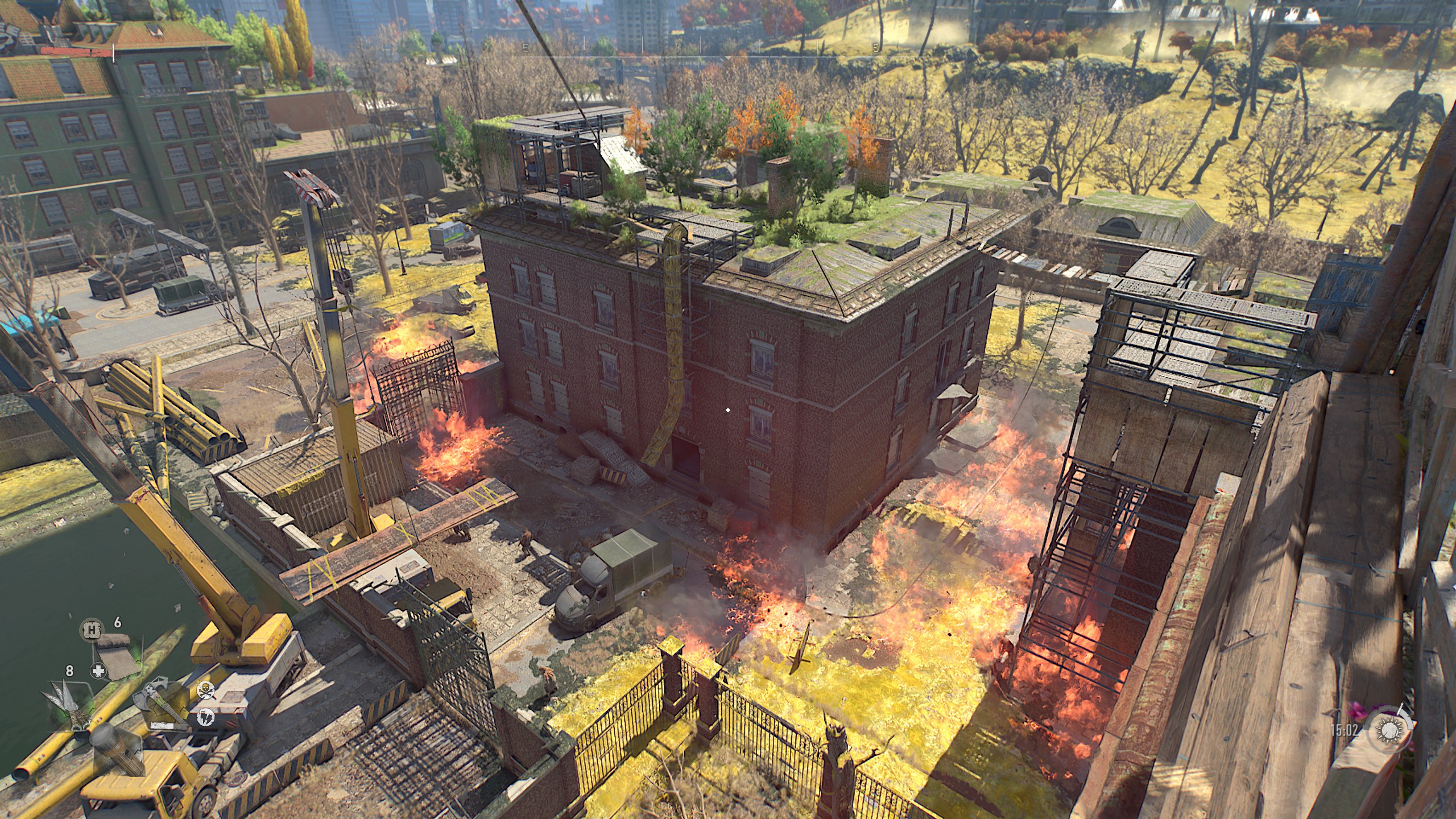
(Image credit: Techland)
Along with the tools to navigate the city, there’s a system to change it as well. Throughout Villedor’s many districts are buildings to conquer like water towers and electrical substations. These buildings form excellent parkour puzzles, especially in the electrical buildings, where you have to connect cables between a series of transformers. The cables have a fixed length, so simply winding them through corridors and up ladders won’t reach. Instead, you have to find the most efficient parkour route from the cable’s source to its correct transformer. Some of these puzzles are pretty intricate, and after vaulting and climbing and swinging around it’s a great feeling to finally plug in that final cable and complete the puzzle.
These choices are about getting to shape the city into the type of playground you want.
Then you’ll have to decide if you want to give control of the building to the Peacekeepers or the Survivors. Each building you turn over to the Peacekeepers will add something to turn the city streets into a playground of traps—car bombs you can detonate, turrets that fling sawblades, exploding lanterns, electrical and pendulum traps—all great if you love dramatically wiping out mobs of zombies on street level. If you’re more into parkouring far above the zeds, giving control to the Survivors means there will be more ziplines, jump pads you can bounce up to the roofs with, airbags you can grab and ride to the ground, extra air vents for your glider, and other parkour-related features which make navigating the city quicker and easier. This system completely undercuts any character drama you’ve been involved in—if you hate the Peacekeepers it may feel strange to hand over control of a building to them. But these choices are about getting to shape the city into the type of playground you want, and that’s honestly more important (at least to me) than which side you align with.
Speaking of character drama, there’s a boatload of it. The story quests will take you back and forth through the city, bookended by lengthy cutscenes as you help out the Survivors and Peacekeepers and occasionally choose which side to favor. The writing isn’t the worst I’ve seen by a long shot, but it’s not particularly good, either. It’s about the quality of a typical zombie film, really, so maybe that’s fitting. On the plus side, Dying Light 2 is refreshingly okay with killing off its characters, even many of the main ones. There was a guy who was constantly an utter dick to me and I fully expected to have to win him over at some point, just because he was part of the faction I was helping. Nope! I got to kill him myself. Avoiding a redemptive story arc for this creep was an absolute treat.
There are a handful of characters I enjoyed. I met a big, bearded, hulking peacekeeper who looked like he’d be a mindless brute but was actually quite thoughtful and clever. There’s a lieutenant who seems like he’d be a real hardass but eventually shows a bit of humor and fondness for his troops. Rosario Dawson stands out as the character of Lawan, basically the Alyx Vance of Villedor in that she seems oddly untouched by the apocalypse, upbeat and charming, a nice change from the overly gruff soldiers and gloomy survivors. And there are a few surprises I didn’t see coming, both in side-quests and the main story.
Tech specs
I got a strong performance with my RTX 2080 and 16GB RAM, running Dying Light 2 with a solid 80-90 fps all over the city on high settings. Unfortunately I wasn’t playing the final version of the game: the build was patched twice during the week I played and I expect there will be a Day One patch as well. One story quest in particular was bugged for me: a character needed to complete an optional task was stuck in the wrong location and non-responsive, which meant having to advance a side-quest before he’d return to his correct position for the main quest. Instead of pop-in, I weirdly had some pop-out: sometimes zombies would simply disappear from exterior locations. At times icons for locations I’d discovered on the map would vanish, and one utility building I’d cleared wouldn’t register as completed, but overall there was little in the way of bugs that really disrupted my experience.
A few other issues: UI like menus and inventory are clearly built with consoles in mind and are weirdly laid out, and while many controls are remappable on the keyboard, a few important ones are not—I can middle-mouse to use my grappling hook, but it’s also bound to Alt which there’s no option to change.
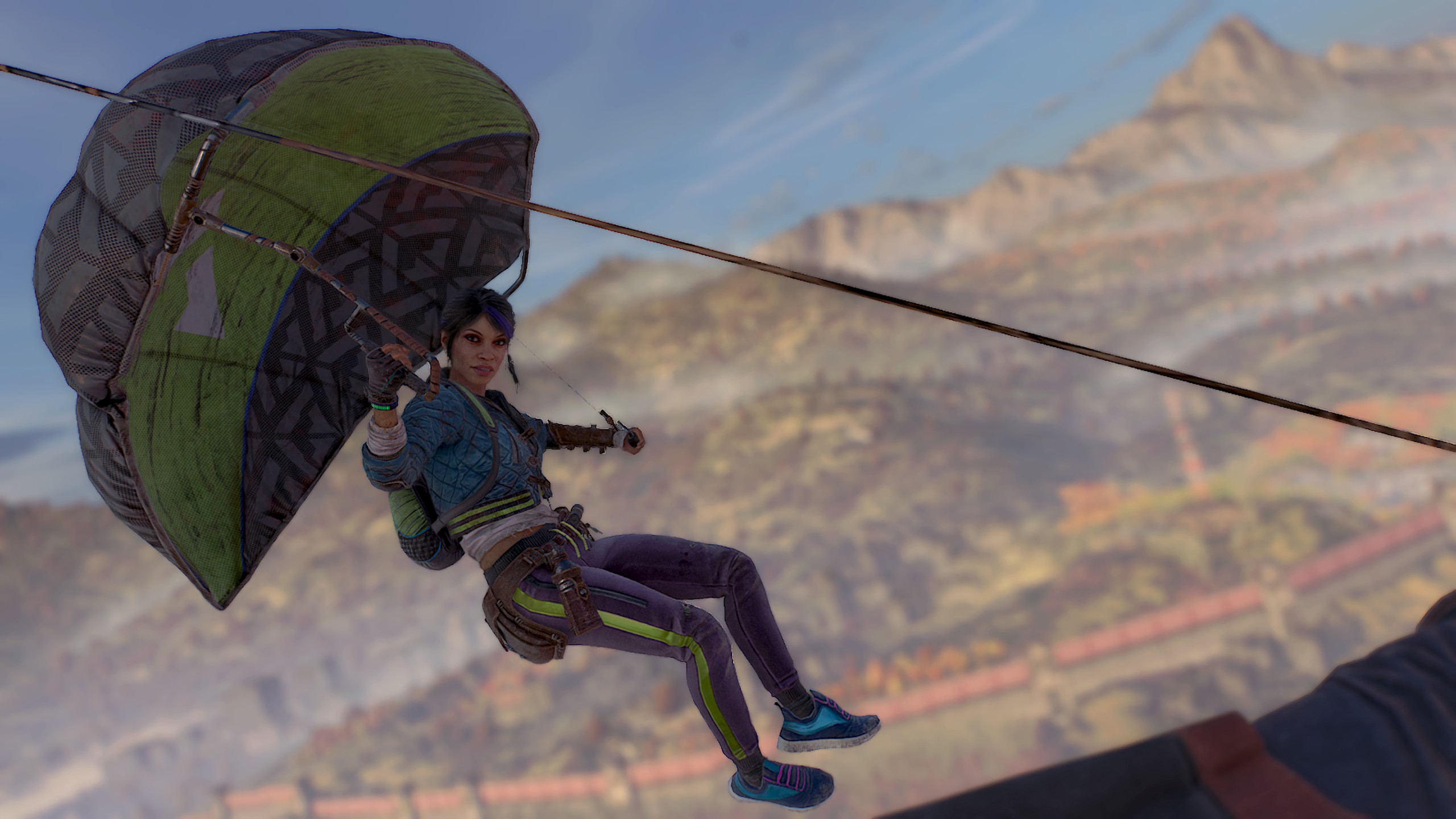
(Image credit: Techland)
Before launch developer Techland said Dying Light 2 would take players 500 hours to fully complete, not just the main story quests but sidequests, challenges, activities, secrets, etc. After playing I almost believe it. Dying Light 2 is a big game, y’all. The city is simply massive, filled with activities and random encounters and rooftop skirmishes, and even with a glider and other parkour toys just crossing a single district takes a good long time. Villedor is even bigger than a cursory glance of the map suggests because there are regions that sprawl well outside the borders. After finishing the story I ran along the edge of a district and discovered there’s a whole underwater portion of the city I didn’t even know existed. This game is huge.
After the 50 hours it took me to complete the main quest, about a dozen sidequests, and a bunch of other activities, I still have plenty to do in Dying Light 2, and I’m keen to keep playing. Hell, even after wrapping up the story there are still a bunch of skills I haven’t unlocked, quests I haven’t begun, and large sections of the city I’ve barely set foot in—not to mention plenty of bandits I’ve yet to set foot on.

